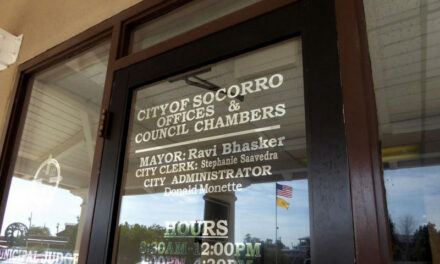A lack of affordable housing in Socorro and surrounding counties makes it difficult for renters to find a place to stay. More funding for the county’s housing authority and a new affordable housing apartment should help address the issue.
All 26 units that Milton Ulibarri rents out in Socorro are full, but he’s still receiving many calls from folks interested in renting from him.
“Mine are full and people are still calling, so there has to be a demand,” he said.
Amber Sisneros is one person on the hunt for an apartment in Socorro. She grew up in Socorro and lived here until 2015 when she had to move for work to Los Chavez, then Belen. Now she’s moving back, but there’s less housing available than she remembers.
“Since this town’s a college town, it feels like a lot more people are coming,” said Sisneros. She checked with the housing authority, looked in the newspaper and online on Zillow, but hasn’t found an apartment yet.
“It’s kind of tricky at the moment,” she said.
The waitlist for housing choice vouchers opened Monday, and will stay open until June 18, said Mary Ann Chavez-Lopez, Executive Director of El Camino Real Housing Authority. The housing authority operates in three counties: Socorro, Valencia and Torrance and is seeing housing shortages in all three. The organization is also the contracting agent for the northern region in Taos. People are also having trouble finding housing in that area, said Lopez-Chavez.
“It gets frustrating when you have people looking and you can’t help or you have a waitlist,” said Chavez-Lopez.
Affordable housing has been a problem, said Lopez-Chavez, who has been the housing authority director since 1997, but lately it seems to be getting worse. The problem, she said, is a lack of affordable rentals.
“In Valencia, the rents have really really gone up, and there’s a shortage because they have new employment there, so a lot more people are moving into Valencia County, and so that makes it a shortage because the more people move in, the more people rent and the more lack of housing is available,” said Chavez-Lopez.
Fewer people have been moving during the pandemic, she said, instead they’re staying put in the units they already have, so fewer units are opening up.
“In Belen, Los Lunas, Valencia County, we had a lot of units, but then you got Facebook coming in, you have all these big distribution centers coming in, so people are coming in from the outside to live in Valencia County, so what happens: the units get taken up. The rents go up,” said Chavez-Lopez.
El Camino Real Housing Authority offers a number of housing programs, from Section 8 vouchers to home rehab for veterans. While home rehabs are important for keeping people in housing they already have, it is difficult to get enough funding for them, said Chavez-Lopez.
Typically the program is given $65,000 for a home rehab, but those funds do not always go far if the home needs issues addressed like a new septic tank, new electrical or a water well. Especially in rural areas, it’s difficult to convince contractors out of Albuquerque or Santa Fe to do the work.
The Section 8 housing program helps subsidize rent for people. The vouchers are good for 60 days, but 30-day extensions can be given up to 120 days. About two to three percent of the people who receive vouchers cannot find a unit within the 120 days, she said, and have to begin the process over again by reapplying.
“We serve as a mediator between the tenant and the landlord, if they’re having issues, we go in and mediate and try to resolve the problem that they’re having,” said Chavez-Lopez.
There are about 45 landlords who work with the Section 8 program in Socorro County, along with 96 in Valencia County and approximately another 25 in Torrance County.
“We used to have a lot more, but units become substandard and landlords get elderly and they pass it on to the kids and a lot of times the kids don’t want to keep going with the units,” said Chavez-Lopez.
Ulibarri began working with the Section 8 program 31 years ago. He’s been a landlord for 42 years but hit a rough patch where he could not find any tenants. Going through the Section 8 program has given him consistent tenants and consistent rent payments.
Chavez-Lopez is hopeful that new landlords can be recruited into the program. There are also many units in the area that cannot go through Section 8 because they would not pass the housing quality inspections, which requires units to meet minimum standards for health and safety, like screens on windows, no broken windows, hot and cold water and functioning electricity.
“It’s like a teeter-totter. You have the vouchers but you don’t have the housing. Then you have the housing but you don’t have the vouchers,” said Chavez-Lopez.
Both new affordable housing and more funding for affordable housing are in the works.
The housing authority received funding for the development of a 32 unit supportive housing apartment called Vista De Socorro. $495,000 in low-income tax credits was approved for the project in late May. The total project will be $6.5 million. The city of Socorro donated the property and will help with road and utility extensions.
The complex will be permanent supportive housing for people having issues with homelessness or with being in and out of the jail system. The units will be available for families and individuals and will offer support services like mental health services and a food pantry. The housing authority has been trying for three years to get funding for the project, said Chavez-Lopez.
In March the Housing Authority also received grant funding for an additional 40 vouchers for people who are elderly or disabled between the ages of 18 and 61.
The housing authority may also receive additional funding through the New Mexico Mortgage Finance Authority or from the county commissioners from money set aside for affordable housing in the American Rescue Plan. Chavez-Lopez does not know yet how much the housing authority could receive or what the application process for those federal funds will look like.
The money in the American Rescue Plan to help with affordable housing sets a higher income level for eligibility. Instead of being between 30 and 40 percent of median income for the area, as it is with other programs, it will be between 100 and 150 percent, which should meet the needs of more people.
“It’s broader, so it’s really going to help a lot of people and I’m really excited about that,” said Chavez-Lopez.






















